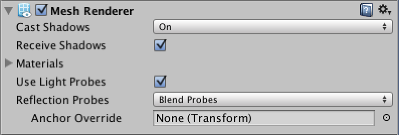Mesh Renderer
The Mesh Renderer takes the geometry from the Mesh Filter and renders it at the position defined by the object’s Transform component.

Properties
| Свойство: | Функция: |
|---|---|
| Cast Shadows | If enabled, the mesh will create shadows when a shadow-casting Light shines on it. The options are On and Off to enable/disable shadows, Two Sided to allow shadows to be cast from either side of the mesh (ie, backface culling is not taken into account) and Shadows Only (ie, the shadows should be visible but not the mesh itself). |
| Receive Shadows | If enabled, the mesh will display any shadows being cast upon it. |
| Materials | A list of Materials to render the model with. |
| Use Light Probes | Enable probe-based lighting for this mesh. |
| Use Reflection Probes | Enable probe-based reflections for this mesh. |
| Anchor Override | A Transform used to determine the interpolation position when the light probe or reflection probe systems are used. |
Details
Меши, импортируемые из других трёхмерных приложений могут использовать несколько материалов. Все материалы, используемые меш рендерером хранятся в списке материалов. Каждый подмеш использует для себя из этого списка один материал. Если к меш рендереру было применено больше материалов, чем есть подмешей в самом меше, тогда первый подмеш будет отрендерен с каждым из оставшихся материалов, одним поверх другого. В ущерб производительности, это позволит вам настроить для этого подмеша многопроходный рендеринг. Но всё-таки полностью непрозрачные материалы будут просто перезаписывать предыдущие слои, не получая от этого никакого преимущества в производительности.
A mesh can receive light from the light probe system and reflections from the reflection probe system depending on the settings of the Use Light Probes and Use Reflection Probes options. For both types of probe, a single point is used as the mesh’s notional position probe interpolation. By default, this is the centre of the mesh’s bounding box, but you can change this by dragging a Transform to the Anchor Override property (the anchor override affects both types of probe). It may be useful to set the anchor in cases where an object contains two adjoining meshes; since each mesh has a separate bounding box, the two will be lit discontinuously at the join by default. However, if you set both meshes to use the same anchor point then they will be consistently lit.